|
 |
 |
 |
 |
|
|
|






Cancer

Cancer has long been considered a cellular disease since cancers are composed of cells that grow without restraint in various areas of the body. Such growths of cancerous cells can replace normal cells or tissues causing severe malformations (such as with skin and bone cancers) and failure of internal organs which frequently leads to death. How do cells become cancerous? Development of cancer is an enormously complex process. For once a cell has started on the cancer path, it progresses through a series of steps, which continue long after the initial cause has disappeared.
There are about as many types of cancers as there are different types of cells in the body (over 100 types). Some cell types constantly divide and are replaced (such as skin and blood cells). Other types of cells rarely or never divide (such as bone cells and neurons). Sophisticated mechanisms exist in cells to control when, if, and how cells replicate. Cancer occurs when these mechanisms are lost and replication takes place in an uncontrolled and disorderly manner. A cancer is generally considered to arise from a single cell that goes bad.
Recent research has begun to unravel the extremely complex pathogenesis of cancer. Underlying the progression of cancer that changes (transforms) normal cells to cancerous cells is an intricate array of biochemical changes that take place within cells and between cells. These biochemical changes lead a cell through a series of steps, changing it gradually from a normal to a cancer cell. The altered cell is no longer bound by the regulatory controls that govern the life and behavior of normal cells.
Cancer is considered the most severe health condition for the following reasons:
 |
 |
 |
|  | It is a common condition and occurs in one of every four persons
|
 |
|  | It will kill most persons that are afflicted even with extensive treatment
|
 |
|  | Cancer causes severe physical and emotional suffering to both patients and their families
|
 |
|  | Cancer is very costly to treat.
|
 |
|  | Cancer can be caused by many factors or agents, many which are unknown
|
 |
|  | Cancer can not be totally prevented. There is no vaccine. However, the probability of getting cancer can be reduced by avoiding known risk factors such as smoking, AIDS, and alcohol.
|
 |
Cancer is not a single disease but a large group of diseases. The common aspects are that all cancers have the same basic property - they are composed of cells gone wild. The cancer cells do not conform to the usual constraints on cell proliferation - they are uncontrolled growths of cells.
Cancer Terminology

The terminology associated with cancer can be confusing and may be used differently among the public and medical communities.
Listed below are definitions for the most frequently used cancer terms:
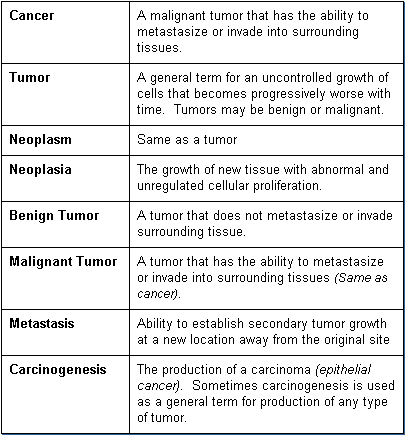
How are Cancers Named?

While most tumors are generally named in accordance with an internationally agreed-upon nomenclature scheme, there are many exceptions. Tumors are generally named and classified based on:
 |
 |
 |
|  | cell or tissue of origin
|
 |
|  | whether benign or malignant
|
 |
Most malignant tumors fall into one of two categories, carcinomas or sarcomas. The major differences between carcinomas and sarcomas are listed below:
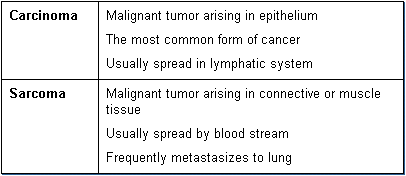
Most tumors end with the suffix "oma", which however merely indicates a swelling or tissue enlargement. [Note: some swellings ending with -oma may not be cancers; for example, a hematoma is merely a swelling consisting of blood].
In naming tumors, qualifiers may be added in addition to the tissue of origin and morphological features. For example, a "poorly-differentiated bronchogenic squamous cell carcinoma" is a malignant tumor (carcinoma) of squamous cell type (original cell type), which arose in the bronchi of the lung (site where the cancer started), and in which the cancer cells are poorly-differentiated (that is they have lost much of the normal appearance of squamous cells).
There are several historical exceptions to the standard nomenclature system, often based on their early and accepted use in the literature.
Examples are:
 |
 |
 |
|  | Benign sounding but actually malignant tumors (e.g., Melanoma, which is malignant, may also be referred to as malignant melanoma. Another example is lymphoma (also malignant) and which is sometimes referred to as malignant lymphoma.)
|
 |
|  | Some tumors are named after the person that first described the tumor, e.g., Wilm's tumor (kidney tumor) and Hodgkin's Disease (a specific form of lymphoid cancer).
|
 |
|  | A few cancers are named for their physical characteristics such as pheochromocytomas (dark-colored tumors of adrenal gland).
|
 |
|  | A few cancers are composed of mixtures of cells, e.g., fibrosarcoma and carcinosarcoma.
|
 |
Examples of benign and malignant tumors of the same cell type are:
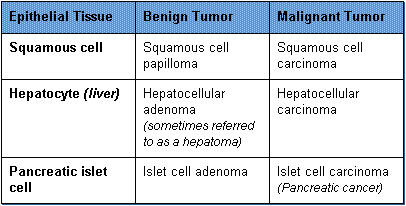
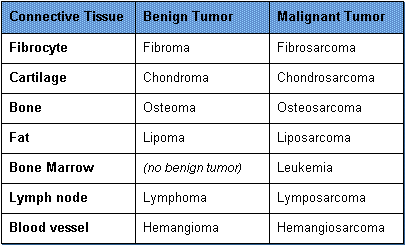


Differences Between Benign and Malignant Tumors

The biological and medical consequences of a tumor are highly dependent on whether it is benign or malignant.
Listed below is a comparison of the primary differences between benign and malignant tumors:
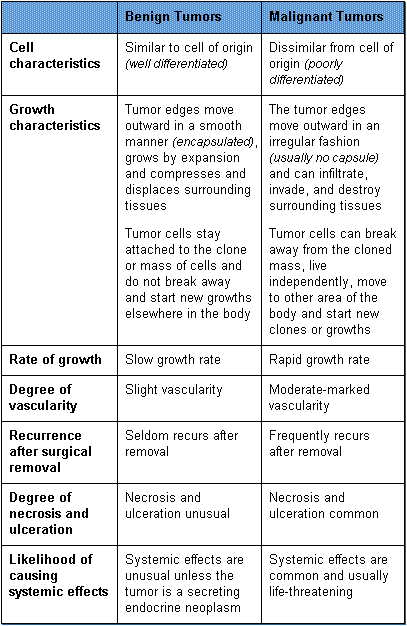
Common Sites for Cancer

Cancer can occur in virtually any tissue or organ. Some cells and tissues are more likely to become cancerous than others are, particularly those cells that normally undergo proliferation are. Those cells that don't proliferate (e.g., neurons and heart muscle cells) rarely give rise to cancers. The following table illustrates the most frequent occurrence of cancers in various body sites.
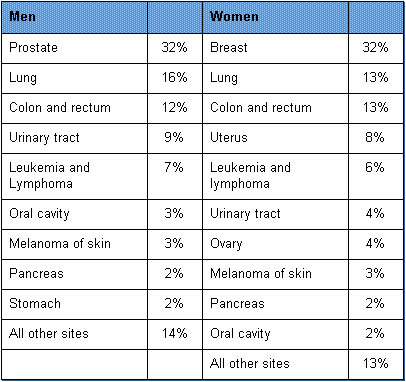
While the prostate is the most common type of cancer that occurs in men, most survive with treatment. In contrast, other types of cancer are more often fatal. For example, the most common cancer, which causes death in men (even with treatment), is lung cancer (33% of cancer deaths in men). With women, a similar situation exists in that the breast is the most common site for cancer but more women also die as the result of lung cancer (23% of cancer deaths in women).
What do Cancers Look Like?

Cancer is a general term for more than 100 different cellular diseases, all with the same characteristic - the uncontrolled abnormal growth of cells in different parts of the body. Cancers appear in many forms. A few types are visible to the unaided eye but others grow inside the body (unbeknown to the affected person) and slowly eat away or replace internal tissues.
An example of a cancer that can be easily seen by the unaided eye is skin cancer. Skin cancers appear as raised, usually dark-colored, irregularly-shaped growths on the skin. As the cancer grows, it spreads to nearby areas of the skin. In advanced cases, the cancer metastasizes to lymph nodes and even organs far away from the original site. The skin cancer illustrated is known as a basal cell carcinoma. Melanomas and squamous cell carcinomas are other common skin cancers. Melanomas are usually the most malignant of the skin cancers.
 |
 |
 |
 |
| |

Basal Cell Carcinoma of the Skin. |
|
Most cancers involve internal organs and will require elaborate diagnostic tests to diagnose. Some large internal tumors can be felt or will push the skin outward and can be detected by noting abnormal bulges or an abnormal feel (for example, hard area) to the body. Thyroid tumors, bone tumors, breast tumors and testicular tumors are cancers that might be felt or observed by the patient. Other internal tumors may only be suspected based on diminished organ function (such as difficulty breathing with lung cancers), pain, bleeding (for example, blood in feces with colon cancer), weakness, or other unusual symptoms. To confirm the actual existence of a cancer may require elaborate diagnostic tests. This is especially the case where the cancer is not growing as a single large lump, but rather as a series of small tumors (metastatic foci) or when widely dispersed throughout the body (such as leukemia).
A few examples of internal cancers are presented in the following figures.
 |
 |
 |
 |
| |

Liver Cancer. Numerous nodules of cancer can be observed so that much of the liver has been destroyed. |
|
 |
 |
 |
 |
| |

Lung Cancer. An early developing squamous cell carcinoma can be seen growing in the middle of the lung. As the cancer develops it will consume more of the lung and metastasize to other areas of the body. |
|
 |
 |
 |
 |
| |

Kidney Cancer. As can be seen the cancer has consumed much of the upper portion of the kidney. |
|
Historical Changes in Incidence of Cancer

Cancer has been recognized in humans for centuries. However, the incidence of various types of cancer has changed since the mid-1900's. This is especially true for lung and stomach cancer. Deaths from lung cancer have tripled from 1950 to 1990 in men. During that same period deaths from stomach cancer death have decreased substantially. Breast cancer has caused more deaths than any other type cancer in women for many decades. However, deaths from lung cancer in women are now greater than that from breast cancer. These changes in types and incidences of cancer reflect the increased longevity of people as well as personal habits and environmental changes.
Latency Period for Cancer Development

Cancer is a chronic condition, which develops gradually over a period of time, and is manifest as a clinical concern many years following the initial exposure to a carcinogen. This period of time is referred to as the "latency period". The latency period varies with the type of cancers and may be as short as a few years to over 30 years. For example, the latency period for leukemia after benzene or radiation exposure may be as short as five years. In contrast, the latency period may be 20-30 years for skin cancer after arsenic exposure and mesothelioma (cancer of the pleura around the lungs) after asbestos exposure.
Survival Time

Success in treating cancer varies greatly with the type of cancer, some cancers respond to treatment whereas others do not. For example, medical treatment of cancers of the pancreas, liver, esophagus, and lung are largely unsuccessful. In contrast, cancers of the thyroid, testis, and skin respond quite well to treatment. Provided below is a table indicating the likelihood of successful treatment (which is commonly measured by 5-year survival).
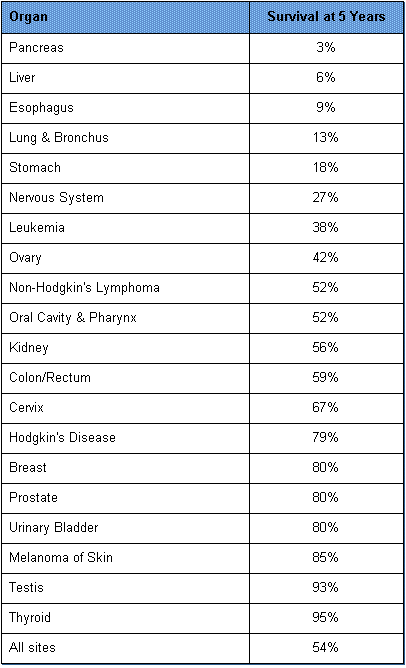
What Causes Cancer?

A very large number of industrial, pharmaceutical, and environmental chemicals have been identified as potential carcinogens by animal tests. Human
epidemiology studies have indeed confirmed that many are human carcinogens as well. However, while it is apparent that chemicals and radiation play a substantial role, it appears that lifestyle and infections are major factors leading to the likelihood that a person will develop cancer. Lifestyle factors are considered to play a causative role in over 75% of the cancer cases. Infections (such as hepatitis and, herpes simplex viruses) appear to be associated with about 10% of the cancer cases.
The tables below show estimates of factors causally related to cancer.
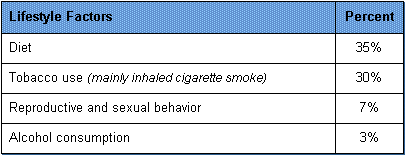
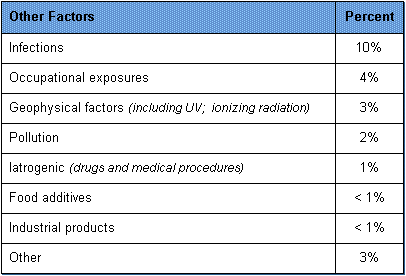
Pathogenesis of Cancer

Carcinogenesis is referred to as a multi-step, multi-factorial genetic disease. All known tumors are composed of cells with genetic alterations that make them perform differently from their progenitor (parent) cells. The carcinogenesis process is very complex and unpredictable consisting of several phases and involving multiple genetic events (mutations) that take place over a very long period of time (at least 10 years for most types of cancer).
Cancer cells do not necessarily proliferate faster than their normal progenitors. In contrast to normal proliferating tissues where there is a strict and controlled balance between cell death and replacement, cancers grow and expand since more cancer cells are produced than die in a given time period. For a tumor to be detected it must attain a size of at least one cubic centimeter (about the size of a pea). This small tumor contains 100 million to a billion cells at that time. The development from a single cell to that size also means that the mass has doubled at least 30 times. During the long and active period of cell proliferation, the cancerous cells may have become aggressive in growth and have reverted to a less differentiated type cell (not similar to the original cell type).
As molecular biology advances, many of the numerous internal and external factors that can positively or negatively influence the development of a cancer are becoming known. While knowledge of the carcinogenesis continues to evolve, it is clear that there are at least three main phases in cancer development:
 |
 |
 |
|  | Initiation
|
 |
|  | Promotion/Conversion
|
 |
|  | Progression
|
 |

The initiation phase consists of the alteration of the DNA (mutation) of a normal cell, which is an irreversible change. The initiated cell has developed a capacity for individual growth. At this time, the initiated cell is indistinguishable from other similar cells in the tissue. The initiating event can consist of a single exposure to a carcinogenic agent or in some cases, it may be an inherited genetic defect. An example is retinoblastoma in which children are pre-disposed to develop the cancer and the defect is passed down through successive generations. The initiated cell (whether inherited or a newly mutated cell) may remain dormant for months to years and unless a promoting event occurs it may never develop into a clinical cancer case. It is suspected that most people have initiated cells that may never progress further.
The promotion/conversion phase is the second major step in the carcinogenesis process in which specific agents (referred to as promoters) enhance the further development of the initiated cells. Promoters often, but not always, interact with the cell's DNA and influence the further expression of the mutated DNA so that the initiated cell proliferates and progresses further through the carcinogenesis process. The clone of proliferating cells in this stage takes a form consistent with a benign tumor. The mass of cells remains as a cohesive group and physically keeps in contact with each other.
Progression is the third recognized step and is associated with the development of the initiated cell into a biologically malignant cell population. In this stage, a portion of the benign tumor cells may be converted into malignant forms so that a true cancer has evolved. Individual cells in this final stage can break away and start new clones of growth distant from the original site of development of the tumor. This is known as metastasis.
While the three-stage pathogenesis scheme describes the basic sequence of events in the carcinogenesis process, the actual events that take place in these various steps are due to activities of specific genes within the DNA of the cells. Cellular DNA contains two types of genes - structural genes and regulatory genes. Structural genes direct the production of specific proteins within the cell. Regulatory genes control the activity of the structural genes and direct the proliferation process of the cell. The three classes of regulatory genes considered to have major roles in the carcinogenesis process are known as:
 |
 |
 |
|  | Proto-oncogenes
|
 |
|  | Oncogenes
|
 |
|  | Suppressor genes
|
 |
Proto-oncogenes are normal or good cellular genes that encode and instruct the production of the regulatory proteins and growth factors within the cell or its membrane. The proteins encoded by proto-oncogenes are necessary for normal cellular cell growth and differentiation. Activation of a proto-oncogene can cause alteration in the normal growth and differentiation of cells, which leads to neoplasia. Several agents can activate proto-oncogenes. This is the result of point mutations or by DNA re-arrangements of the proto-oncogenes. The product of this proto-oncogene activation is an oncogene. Many proto-oncogenes have been identified and have usually been named after the source of their discovery, e.g., the K-ras proto-oncogene was named for Dr. Kirsten's discovery using a rat sarcoma virus. H-ras, c-myc, myb, and src are other examples of proto-oncogenes. The proto-oncogenes are not specific for the original species but have been found in many other species, including humans. These proto-oncogenes are present in many cells but remain dormant until activated. Either a point mutation or chromosomal damage of various types can induce activation. Once activated they become an oncogene.
Oncogenes are altered or misdirected proto-oncogenes which now have the ability to direct the production of proteins within the cell that can change or transform the normal cell into a neoplastic cell. Most oncogenes differ from their proto-oncogenes by a single point mutation located at a specific codon (group of three DNA bases that encodes for a specific amino acid) of a chromosome. The altered DNA in the oncogene results in the production of an abnormal protein that can alter cell growth and differentiation. It appears that a single activated oncogene is not sufficient for the growth and progression of a cell and its offspring to form a cancerous growth. However, it is a major step in the carcinogenesis process.
Tumor suppressor genes, sometimes referred to as anti-oncogenes, are present in normal cells and serve to counteract and change the proto-oncogenes and altered proteins that they are responsible for. The tumor suppressor genes serve to prevent a cell with damaged DNA from proliferating and evolving into an uncontrolled growth. They actively function to effectively oppose the action of an oncogene. If a tumor suppressor gene is inactivated (usually by a point mutation), its control over the oncogene and transformed cell may be lost. Thus the tumor-potential cell can now grow without restraint and is free of the normal cellular regulatory control. The suppressor gene most frequently altered in human tumors is the p53 gene. Damaged p53 genes have been identified in over 50% of human cancers.
The p53 gene normally halts cell division and stimulates repair enzymes to rebuild and restore the damaged regions of the DNA. If the damage is too extensive, the p53 commands the cell to self-destruct. An altered p53 is incapable of these defensive actions and can not prevent the cell with damaged DNA from dividing and proliferating in an erratic and uncontrolled manner. This is the essence of cancer. Recent studies have shown that an altered p53 can be inherited and affected new borne babies are thus susceptible (at higher risk) for certain types of cancer for the remainder of their lifetime.
This represents only a brief overview of an enormously complex process for which knowledge is continuously evolving with the new tools of molecular biology. New factors (such as Tumor Necrosis Factor) are continuously being identified; however, many pieces of this cancer puzzle remain elusive at this time.

  
|
|
|
|